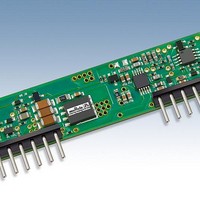LSN2-T/30-D12G-C Murata Power Solutions Inc, LSN2-T/30-D12G-C Datasheet - Page 6

LSN2-T/30-D12G-C
Manufacturer Part Number
LSN2-T/30-D12G-C
Description
DC/DC Converters & Regulators 12Vin 0.8-5Vout 30A 150W Power Good Out
Manufacturer
Murata Power Solutions Inc
Series
LSN2r
Datasheet
1.LSN2-T30-D12-C.pdf
(16 pages)
Specifications of LSN2-T/30-D12G-C
Output Power
150 W
Input Voltage Range
6 V to 14 V
Input Voltage (nominal)
12 V
Number Of Outputs
1
Output Voltage (channel 1)
0.8 V to 5 V
Output Current (channel 1)
30 A
Package / Case Size
SIP
Output Type
Low Voltage Selectable
Output Voltage
0.8 V to 5 V
Product
Non-Isolated / POL
Lead Free Status / RoHS Status
Lead free / RoHS Compliant
Other names
LSN2-T/30-D12G-C
of your line voltage and source impedance, as well as your particular load and
layout conditions.
Input Fusing
Most applications and or safety agencies require the installation of fuses at the
inputs of power conversion components. The LSN2-T/30-D12 Series are not
internally fused. Therefore, if input fusing is mandatory, either a normal-blow
or a slow-blow fuse with a value no greater than twice the maximum input cur-
rent calculated at low line with the converter’s minimum effi ciency should be
installed within the ungrounded input path to the converter.
Safety Considerations
LSN2-T/30-D12 SIPs are non-isolated DC/DC converters. In general, all DC/DC’s
must be installed, including considerations for I/O voltages and spacing/separa-
tion requirements, in compliance with relevant safety-agency specifi cations
(usually UL/IEC/EN60950-1).
(safety extra low voltage) requirements, its input must be SELV compliant. If the
output needs to be ELV (extra low voltage), the input must be ELV.
Input Overvoltage and Reverse-Polarity Protection
LSN2-T/30-D12 SIP Series DC/DCs do not incorporate either input overvoltage
or input reverse-polarity protection. Input voltages in excess of the specifi ed
absolute maximum ratings and input polarity reversals of longer than “instan-
taneous” duration can cause permanent damage to these devices.
Start-Up Time
The V
ing input voltage crosses the lower limit of the specifi ed input voltage range
and the fully loaded output voltage enters and remains within its specifi ed
accuracy band. Actual measured times will vary with input source impedance,
external input capacitance, and the slew rate and fi nal value of the input voltage
as it appears to the converter.
On/Off Control with the nominal input voltage already applied to the converter.
The most effective combination of external I/O capacitors will be a function
In particular, for a non-isolated converter’s output voltage to meet SELV
The On/Off to V
IN
to V
OUT
Start-Up Time is the interval between the time at which a ramp-
Figure 3. Measuring Output Ripple/Noise (PARD)
OUT
Start-Up Time assumes the converter is turned off via the
www.murata-ps.com
The specifi cation defi nes the interval between the time at which the converter
is turned on and the fully loaded output voltage enters and remains within its
specifi ed accuracy band. See Typical Performance Curves.
Remote Sense
LSN2-T/30-D12 Series offer an output sense function. The sense function
enables point-of-use regulation for overcoming moderate IR drops in conduc-
tors and/or cabling. Since these are non-isolated devices whose inputs and
outputs usually share the same ground plane, sense is provided only for the
+Output.
DC/DC converter’s output. The sense line carries very little current and conse-
quently requires a minimal cross-sectional-area conductor. As such, it is not a
low-impedance point and must be treated with care in layout and cabling. Sense
lines should be run adjacent to signals (preferably ground), and in cable and/or
discrete-wiring applications, twisted-pair or similar techniques should be used.
To prevent high frequency voltage differences between V
recommend installation of a 1000pF capacitor close to the converter.
the +Output and +Sense pins that do not exceed 10% of V
rent and voltage at the converter’s output pins. Use of trim and sense functions
can cause the output voltage to increase, thereby increasing output power
beyond the LSN2-T/30-D12’s specifi ed rating. Therefore:
serves to protect the sense function by limiting the output current fl owing
through the sense line if the main output is disconnected. It also prevents
output voltage runaway if the sense connection is disconnected.
must be tied to +Output at the DC/DC converter pins.
Remote On/Off Control
Normally this input is controlled by the user’s external transistor or relay or is
permanently grounded. With simple external circuits, it may also be selected
by logic outputs. The On/Off control takes effect only when appropriate input
power has been applied and stabilized (approximately 7msec).
The output will then always be on (enabled) whenever appropriate input power
is applied.
control current (approximately 1mA max.) and not overdrive the input greater
than the +V
activating the On/Off control.
The remote sense line is part of the feedback control loop regulating the
The sense function is capable of compensating for voltage drops between
Power derating (output current limiting) is based upon maximum output cur-
The internal 10.5Ω resistor between +Sense and +Output (see Figure 1)
Note: If the sense function is not used for remote regulation, +Sense
For negative polarity, the default operation leaves this pin grounded or LOW.
Dynamic control of the On/Off must be capable of sinking or sourcing the
[V
(V
OUT
OUT
IN
(+) – Common] – [Sense(+) – Common] ≤ 10%V
at pins) x (I
power input. Always wait for the input power to stabilize before
25 Jun 2010 MDC_LSN2-T/30-D12
LSN2-T/30-D12 Series
OUT
DOSA-SIP, 30A POL DC/DC Converters
) ≤ rated output power
email: sales@murata-ps.com
OUT
Series.B20Δ
OUT
and Sense, we
OUT
.
Page 6 of 16






















